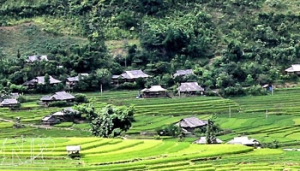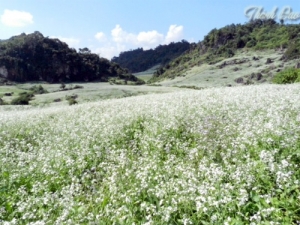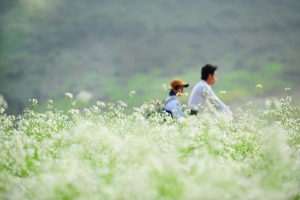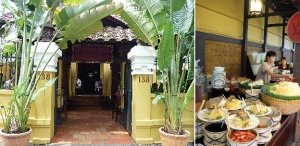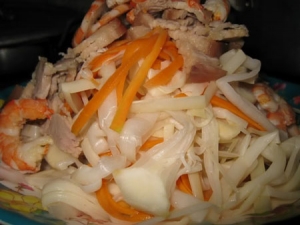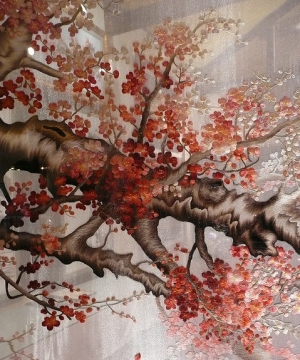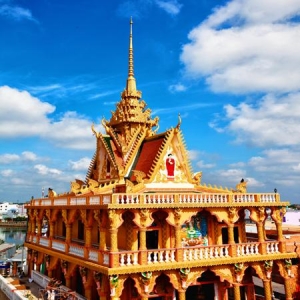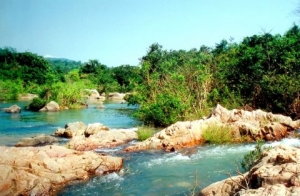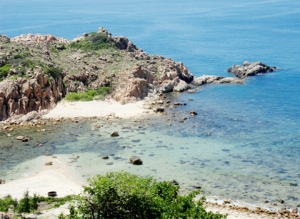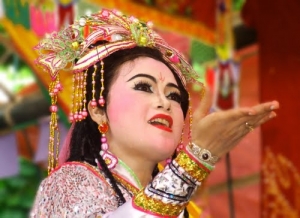
Asia Pacific Travel Team
Ang Village - A water-color painting of Northwestern mountains
Located in Moc Chau Plateau (Moc Chau District, Son La Province), Ang Village has fresh and cool air, charming scenery and also preserves special culture treasures of Thai ethnic group.Near to the village is natural lake with the area of 5ha surrounding by green pine forests. In the distance, there are verdant tea hills, grass fields; especially in the spring, white flowers of apricots, plums, ban (a typical flower of Northwest region) blooming throughout the forests. All seem to emphasize the beauty of Ang Village more sparkling, charming.
Fields of pristine white flowers in Moc Chau Plateau
Located in Son La province, at a distance of 200 kilometers from Hanoi, Moc Chau Plateau is 1,050 meters above the sea level, with an area of about 80 kilometers in length and 25 kilometers in width.
Anyone who has ever come to Moc Chau all knows that Moc Chau Plateau is famous for a large herd of milk cows, immense tea plantations, big gardens of plum and apricot trees, and large green grass field of about 1,600 hectares.
The winter of this year comes and its sign is vast fields of delicate white flowers covering this dreamlike plateau.The wildflowers are blossoming a lot, but pristine white flowers are still stunning in tourists’ eyes at all.
Ecstasy with the fields of napa cabbage flowers in Moc Chau
Moc Chau, a plateau of Son La Province, which is 190 kilometres northwest of Hanoi. It's a favorite destination for tourists in Vietnam tourism with its wildness of green land and the paradise of flowers. People often say: dairy cow + green tea + white plum = Moc Chau. In fact, it's more and more charming.
Enjoy cusine in Ho Chi Minh City
There's a palpable energy in the streets of Ho Chi Minh City. The city formerly known as Saigon is the epicenter of Vietnam's capitalist heartbeat, and since the enactment of economic reforms in the late 1980s, the country has been slowly transforming from rags to riches, with Saigon as its poster child for economic prosperity.
Bồn bồn - A wild and tasty plant
It would be a shame if someone visited the Mekong Delta province of Ca Mau and came away without trying dishes made from bồn bồn.
Bồn bồn (cattail, or bulrush) is a reed-like wild plant with long, firm leaves, olive-green, three-sided stems and drooping clusters of small spikelets. It usually grows in swamps or wetlands, and is known to be useful for land restoration and as an ingredient in food.
Some parts of Ca Mau Province are high in alum and are therefore not good for growing rice paddy, only bồn bồn.
Many families do grow the wild plant as a crop.
The root produces an edible tuber that is considered delicious and healthy. It is distinctively sweet, crunchy, crispy, and soft. It tastes a bit like lotus root and bamboo shoot.
At first people only used it as a pickle. But gradually, as locals began to migrate, they took the plant with them and it made its way into many dishes.
Some of the most popular are braised anabas with pickled bồn bồn, bồn bồn with sour catfish hot pot or sour snakehead hot pot, stir-fried bồn bồn with shrimp, and bồn bồn salad with shrimp and pork.
Pickled bồn bồn remains popular. To pickle it, one uses only the inner white portion of the stalk. Remove the tough outer layer and soak the white portion in salt water with some condiments.
A week later the pickle is ready: it is slightly sour and crispy, and looks like the rustic dish it is. It is delicious if stir-fried with shrimp, meat, or fish, or cooked in sour soup with fish. Also popular is pickledbồn bồn along with braised anabas, catfish, and snakehead fish.
Stir-fried bồn bồn with shrimp is possibly the tastiest of the lot and also easiest to make. The distinctive sweetness of the wild plant remains intact when cooked with little or no condiments.
To make the dish, peel shrimp and get the inner white portions of the stalk and clean them. Pour a little oil on the pot over heat, add some onion for flavor, add the shrimp and then the bồn bồn, and stir-fry together with some condiments.
The dish is served with hot rice.
Bồn bồn salad with shrimp and meat seems to be the most popular dish in restaurants. It is a combination of sour, spicy, salty, and sweet tastes, all essential aspects of southern cooking. Some make the salad with pickled bồn bồn to get many flavors, while others prefer fresh bồn bồn to enjoy the plant’s distinctive sweetness. The tuber is a bit crispy but not tough, the fresh leaves do not fall apart, and the dish seems to melt in the mouth. Black tiger prawn and soft meat with a little fat is often used to make the salad even more delicious. It is served with shrimp crackers as an appetizer at family parties and wedding banquets.
Bồn bồn can be combined with dried shrimp, beef, and pork to make simple but tasty meals at home. Depending on the other ingredients, and how long and how thick the bồn bồn is, one can cook numerous delicacies with the plant.
If customers cannot enjoy bồn bồn delicacies in the Mekong Delta, they can find it at restaurants inHo Chi Minh City. Or buy it from markets or supermarkets and cook it themselves.
Bồn bồn costs around VND50,000 a kilogram.
Vietnamese Embroidery Painting
Worked completely by hand, each embroidery painting is intricately stitched using select strands of silk or cotton thread in coordinated colors and hues reflective of the scene being depicted.
Viewed from a distance, our Vietnamese silk "embroidery paintings" are often easily mistaken for the handiwork of an artist's brush magically blending raw color into a timeless masterpiece. But up close, the eye feasts on the intricate density of thousands of silk strands exquisitely embroidered on cloth in such a way that the detail in the hand work rivals the detail of the imagery itself.
In face, you must hold the embroidery in your hands, feel its weight, to properly understand that thousands of tiny hand-stitches can blend together to form such authentic art.
 For each embroidery artist, thread is their paint, the needle is their brush. With extraordinary patience, the artist selects carefully each thread they use, and in several cases may incorporate up to 500 different types and colors of thread into each piece of art.
For each embroidery artist, thread is their paint, the needle is their brush. With extraordinary patience, the artist selects carefully each thread they use, and in several cases may incorporate up to 500 different types and colors of thread into each piece of art.
The paintings can take from three weeks to several months to complete, and require that the artist be not only a highly-skilled needle artist, but have the "eye"and artistic talent to accurately render the scene before them.
By means of comparison, the work of embroidery painting is more difficult than any other form of embroidery, requires much more patience than either sculpting or traditional painting do. And only in Vietnam will you find this particular embroidery technique.
Hand embroidery holds a unique place in Vietnam's cultural history. Along with cooking and sewing, it is one of the most popular extra-curricular activities in which young high-school girls engage.
Since the 1960's, hand embroidery painting in Vietnam has been raised to the level of an art, and many male and female are all embroidery artists. Look in on our gallery of pictures.
Embroidery paintings from World Threads are guaranteed to brighten up any home, and certainly that you will enjoy the unique and artistic value of these masterpieces.
These are some photos of Embroidery paintings:



An unique and sophisticated architecture of Pitu Khosa Rangsay Pagoda
To Khmer people, Pitu Khosa Rangsay pagoda, one of the most beautiful temples in the delta due to its sophisticated architecture and the spiritual values that it brings, is not only a place to worship and to keep sculptural and fine arts works but also an integral part of their culture.
Located at 27/18 Mac Dinh Chi Road, Ninh Kieu District, Can Tho City, the Temple is named Chua Sau (After Pagoda) because at that time on the main Hoa Binh Boulevard there stood the Rangsay Muni Pagoda or Chua Truoc First (Pagoda). It covers 500m2 and includes many areas such as a sanctum, monk house, gate and bell tower, and has three floors, constructed from reinforced concrete masonry.
The four buildings which are decorated with delicate patterns display an Angkor dragon, fairy Keynor, sacred bird Krud, god Hanuman, goddess Teppanom which are majestic.
The pagoda gate is built meticulously with elegant carvings on the rooftop with a bas-relief of Buddha and large embossed pillars. To the pagoda, visitors will see many statues of snakes and dragons on the roofs, bird-human Garuda, fairy Kayno and Goddess Reahu on the sanctum or many images of elephants, birds, flowers, clouds as well as legends of Buddha on walls and pillars.
The whole architecture whilst keeping with the unique characteristics of Khmer culture has stylized modern harmony between Angkor and Khmer people in the delta.

A small alley heading to the Pitu Khosa Rang Pagoda in Can Tho.
Ham Ho – The waterfall of flying fish
Binh Dinh is the land of full sunshine, wind and the briny taste of sea; and it makes a strong impression on tourists even for hard-to-pleasure people by many charming and fascinating landscapes.
One of the attractive destinations that visitors shouldn’t miss coming here is Ham Ho. At the distance of more than 50 kilometers Northwest of Quy Nhon city, Ham Ho is a downstream part of Kut River in Tay Son, Binh Dinh province that is associated with the special legend. It was told that Kon River and Kut River’s lower section was in a terrible drought thousands of years ago. In a drought year when people wanted rain, it is unique phenomenon that there were many strange sounds like people screaming and praying for rain at the bend of river. Perhaps, witnessing that disaster and listening to that pray of locals, Rain God created the two river’s lower section to save people here. Hence, this region is called Ham Ho or “ Yelling Cellar”.
This part of Kut River is about 1 kilometer, however, just needing to go by boat about over half a kilometer on the way leading to inner to lake area, tourist’s tiredness will seem to disappear thank to its beautiful natural beauty with lush green all year long together with cool streaming water. Tourists can experience mountain views, abundant birdlife, fragrant wild flowers, unusual trees and plants. Specifically, along the riverside are a dense forest mixed with high cliffs, dotted by a number of marble outcrops with varied strange shapes. It is said that the more tourists get deep into, the more interesting scenery is. With the depth of 30 meters, the bed of river is full of gleaming and bright granite stones like millions of diamonds in the green and clear water. There are many particular stones places, each of which is attached to the meaningful story such as Jar of Wine, Footprint of Giants, and Fairy Chess Board…
Ham Ho is also well known by not only a considerable number but also a variety of fish, especially in the flood season. It is told that Water King (the God that governs lakes, rivers and the ocean) holds a waterfall crossing examination for fishes in Ham Ho at this time of a year. The fishes that pass this contest will turn into dragon. Hence, Ham Ho waterfall is also called Vu Mon or Flying Fish waterfall.
In the rainy season (April-October), the forests at Ham Ho turn into a green carpet dotted with splendid flowers and in the dry season (November-March), the river water is pure and the air is cold. One of the most interesting times to visit is when the Loc Vung ornamental trees (lecythidales) come into flower. The nature here creates a lively and fanciful drawing that makes Ham Ho become an ideal place for tourist to relax. Tourists can go boating and fishing, walk in the forest, swim or just relax in one of the stilt houses on the banks of the river. Adventurers can kayak on the river, or take a ride in a small canoe with two local guides dressed in ancient soldier's costumes.
The pristine and tranquil island
The pristine beach with smooth white sand and blue water stretching away to the horizon without human’s foot, a variety of colorful coral reefs together with the peaceful life of rustic locals are the specific features that makes a strong impression on tourists about pretty Island named Binh Ba.
Just needing to spend about 2 hours on the boat from Ba Ngoi port, tourists will put their feet in this nice island. Binh Ba Island lies across Cam Ranh Bay as a screen to prevent the waves from East Sea pouring in. It is said that this island is not so noisy, busy and urbanized as surrounding areas such as Nha Trang and Mui Ne. Perhaps, if someone has opportunity to put his feet on this is land, it is strongly believed that he will never forget quiet space along with pure wild of the nature here. And this amazing attraction comes from the natural beauty of Bai Nom and Bai Chuong.
The island's most beautiful beach is Bai Nom. It is a bow-shape sandy beach, and two sides are solid rocks. The sand is so white. In this season, the waves are very intense. Just stood about five meters from the shore, tourists will be very hard to keep their foot away from the big waves. At the weekend, hundreds of guests go to the island and stopover at Bai Nom playing with the waves. Leaving Bai Nom, walking on the roads rising full of green trees and wildflowers, tourists will wallow in the quiet and pristine beach of Bai Chuong. Maybe, the attraction of Bai Chuong is really not because of the smooth white sand like Bai Nom, but comes from the beauty of splendid colorful coral reefs, iridescent shells, and undulating stones with diversified shapes on the sea and especially steep cliffs together with mysterious caves. In addition, nothing is better than contemplate the beauty of sunrise, sunset and the moon in Binh Ba Island. Thus, it is not surprising when many tourists want to come back even once.
Cai Luong or Renovated Opera
In comparison with cheo (popular opera) and tuong (classical opera), cai luong is a new type of theatre in Vietnam, combining drama, modeled after French comedy, and singing.

Cai Luong (Renovated Opera) appeared in the southern part of Vietnam in the 1920s. Now, this form of music is a new type of theatre.
Scenes are elaborate and are changed frequently throughout the play. Cai luong is similar to the Western operettas and more easily depicts the inner feelings of the characters. Songs of the Cai luong are based on variations of a limited number, perhaps 20, of tunes with different tempos for particular emotions - thisconvention permits a composer to choose among 20 variations to express anger, and as many to portray joy.
The principal supporting songs in Cai Luong is the Vong Co (literally, nostalgia for the past). Cai luong owes much of its success to the sweet voices of the cast, much appreciated by the audience. Upon hearing the first bars of the well-loved Vong Co, the audience reacts with gasps of recognition and applause.
The Cai luong performance includes dances, songs, and music; the music originally drew its influences from southern folk music. Since then, the music of Cai luong has been enriched with hundreds of new tunes. A Cai luong orchestra consists mainly of guitarswith concave frets, and danakim.
Over the years, Cai luong has experienced a number of changes to become a type of stage performance highly appreciated by the Vietnamese people as well as foreign visitors in Vietnam tourism.
{jcomments on}


